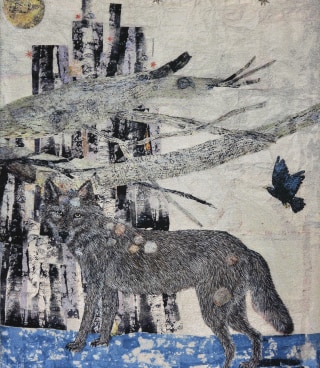Kiki Smith: Free Fall
Kiki Smith: Free Fall is Kiki Smith’s first solo exhibition held at a public museum in Asia. Occupying a unique space in contemporary American art of the 1980s–90s through her deconstructive expression of the body, Smith continues to be active in her practice. By way of Seoul Museum of Art’s institutional agenda of “production” and exhibition agenda of “poetry,” the show has taken the keyword “free fall” in presenting features of the artist that encompass aspects of a producer in multi-media experimentation, as well as those that have allowed her to vary her formative rhythms according to the undulations of the times. Smith has always opted for a non-linear narrative instead of a clear-cut answer between the binary divisions of life and death, reality and ideals, material and immaterial, and male and female. Her attentiveness to “all creatures great and small” and casting a message of coexistence with a deep, considered breath are indeed values worth paying attention to again today when terms like “excess,” “inundation,” and “surplus” have become all too familiar. Free Fall, which is also the title of a work of Smith’s produced in 1994, points to the eruptive and vital energy as well as the wandering movement inherent in her work, bringing together the past forty years of her vast media experiments and artistic practice that engaged in weaving transcultural narratives which go beyond mere female-centric narratives. Immediately reminding us of a downward falling movement, “free fall” symbolizes the dynamism implicit in Smith’s exploration of the fragmented body, but it also conveys the performative posture that has allowed her to expand the boundaries of media and concepts through a kind of wandering akin to the moon’s free-falling orbit around the Earth. Based on these characteristics, the exhibition introduces more than 140 works spanning sculpture, prints, photography, drawings, tapestry, and artist’s books.
America in the 1980s can be summarized by its focus on human rights, equality, identity, and gender discourse with issues surrounding AIDS and abortion rights. Against this backdrop, the art scene moved against minimalism or Abstract art, often regarded as symbols of male chauvinism, and toward employing the body as art’s subject matter and material. Many feminist artists during this time subverted the prevalent attitude that understood women’s bodies as aesthetic objects and instead brought them into a place where their expression happened with agency. Meanwhile, Smith, having lost some family members during this time, peered into life’s frailty and imperfections. From this peering came her ways of thinking across the border between the inside and outside of the body, and with this attitude, spirituality and materiality were combined. Smith, who took a non-hierarchical approach in her exploration of the body, became a key figure of abject art, boldly dealing with the segmented and fragmented body as well as bodily fluids like menstrual blood, sweat, tears, semen, urine, and other excreta. Her early works were created based on her interest in the human anatomy, focusing on depicting parts of the body, but this scope was soon expanded to give form to full-length figures as well as installation pieces. Coming into the 2000s, Smith created lyrical narratives out of familiar fables like Little Red Riding Hood and fairy tales like Alice in Wonderland, while also gradually expanding the radius of her work to include subjects like animals, nature, and the universe. Her macroscopic view, which allowed her to broaden the scope of her subjects and iconographies, can also be found in her experiments with media.
In order to effectively tie together Smith’s journey of the past several decades, through which her formative grammar has differed for each period, this exhibition takes neither a chronological approach nor the existing prescriptive approach centered around modifiers that have surrounded the artist like “female” or “the body.” Smith says the reason she became interested in the body was not simply to emphasize the feminine in a new way but “because it is the one form that we all share; it’s something that everybody has their own authentic experience with,” and it is this multiplicity of interpretations that became a crucial starting point for this exhibition. The exhibition thus proposes three loosely connected themes based on elements such as “narrative structure,” “recurring elements,” and “energy,” which can be found consistently throughout her œuvre, from her early works to her more recent works. This looseness is intentional, giving precedence to Smith’s diverse formative language and the mechanism of its grammar, while also allowing the possibility of multiple layers of interpretation. Smith has called her own artistic practice a kind of “walking around in a garden.” This symbolizes the wandering movement of a thought that lingers around various media and concepts as well as their borders. And this movement is fully transferred to the screen today, with reverence for all life that is marginalized, insignificant, or not yet reached. Having gone through the 1980s–90s up to the present day, repeating to adapt and run counter to the undulations of the times, Smith says, “I am still in free-fall.” Our hope is that this exhibition would offer the audience the opportunity to find a starting point for their own story while following the various movements of Kiki Smith that could be summarized as “free fall.”

